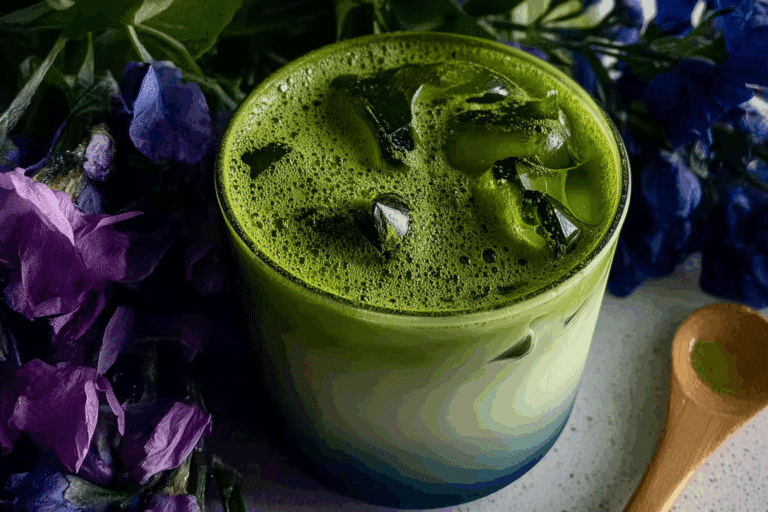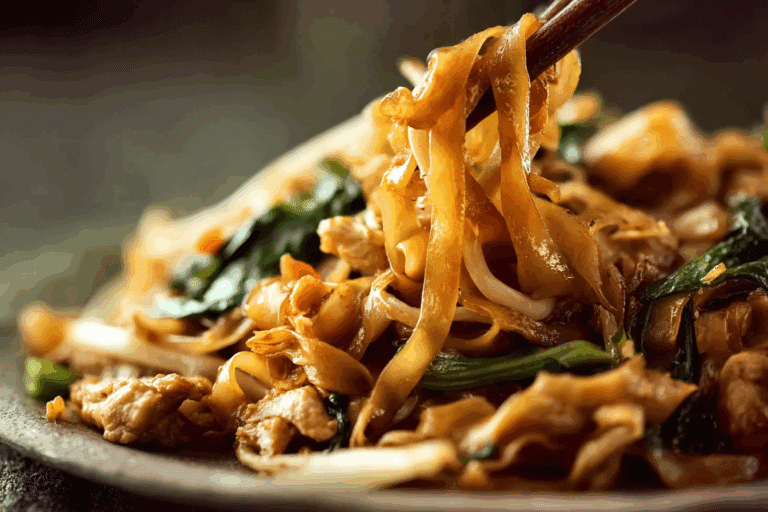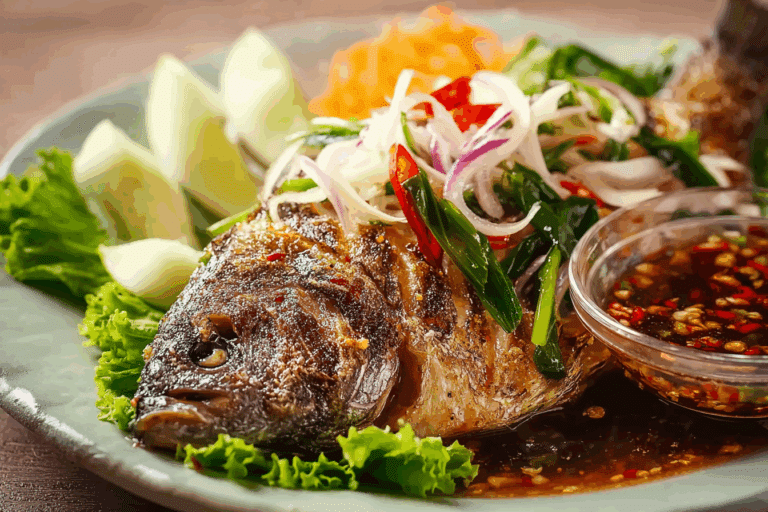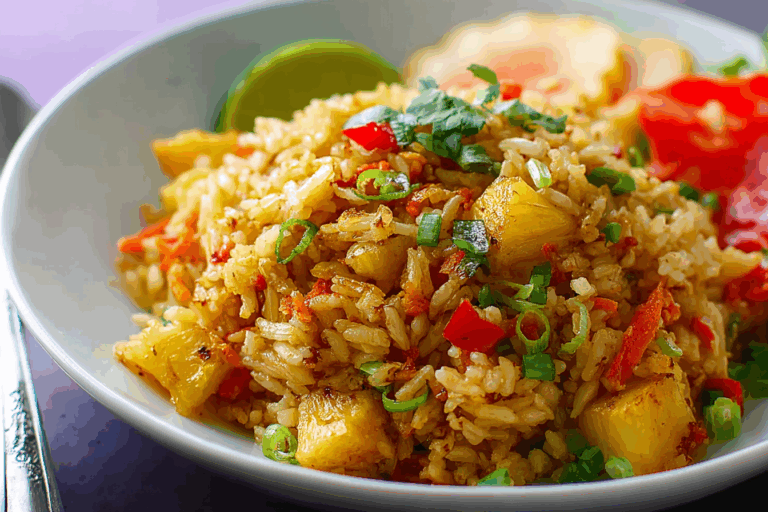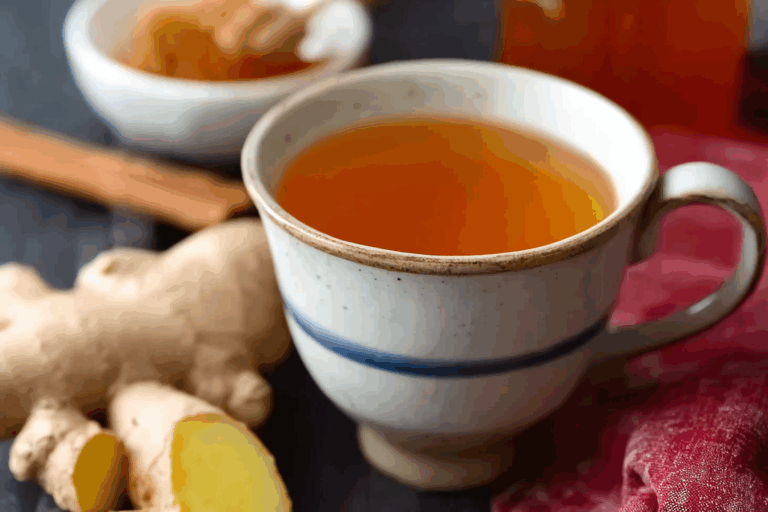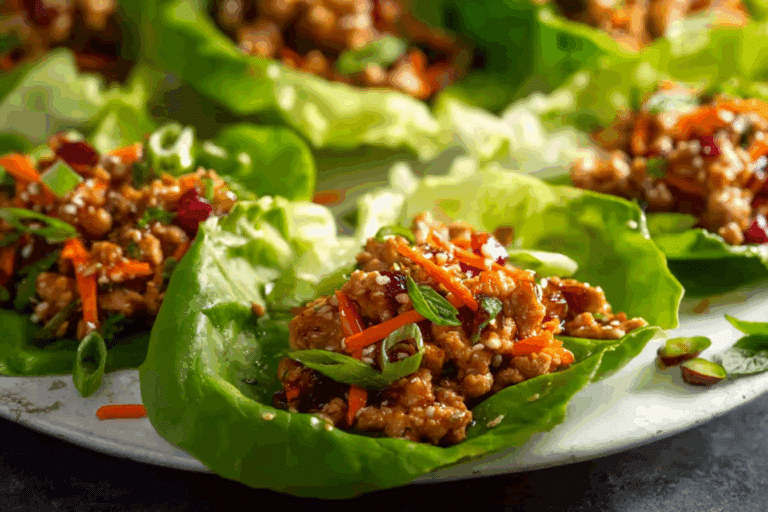Thai Stink Beans with Shrimp: The Ultimate Thai Stir-Fry
Thai Stink Beans with Shrimp might sound like a bold choice for dinner, but trust me, once you take that first bite, you’ll wonder how you ever lived without it. This traditional southern Thai dish, often called Goong Pad Sataw, combines the nutty crunch of petai beans with the savory depth of shrimp paste and the fiery punch of southern curry paste. It’s a recipe that not only awakens your taste buds but also connects you to the heart of Thai home cooking.
When I first discovered this dish, I was exploring southern Thailand and was warmly welcomed by a family who had a little eatery tucked away in the village. On their menu board, scribbled in chalk, was something I had never heard of before: Thai Stink Beans with Shrimp. The name itself made me smile, and their passion for sharing their family’s food history made me fall in love instantly.
If you’ve ever browsed through my About Page on this site, you know my cooking journey started with my grandmother’s kitchen. Her dishes were never just food they were stories, traditions, and ways to bring people together. That same spirit is what I felt when I learned to make Thai Stink Beans with Shrimp. This isn’t just a recipe it’s a story, a journey of flavors passed down through generations in southern Thailand. And today, I’m sharing that journey with you, so you can bring a taste of authentic Thai cooking right into your kitchen.
In this article, you’ll not only learn how to cook Thai Stink Beans with Shrimp step by step, but you’ll also discover the cultural roots of this unique dish, cooking tips, flavor variations, and even how to store it for later. Ready to cook something truly delicious and unforgettable? Let’s dive in.
Table of Contents
Table of Contents
Ingredients for Thai Stink Beans with Shrimp
The beauty of Thai Stink Beans with Shrimp lies in its simplicity. The ingredients are humble but powerful, each one playing a critical role in the balance of flavors.
Main Ingredients:
- 400 grams shrimp (fresh, deveined; tails left on for presentation if desired)
- 2–3 heaping tablespoons southern Thai curry paste (homemade or store-bought)
- 1 cup shelled stink beans (about 6 pods, peeled carefully)
- ½ teaspoon shrimp paste
- ½ tablespoon oyster sauce
- ½ tablespoon sugar (optional; use less or none for a less sweet taste)
- 6–8 kaffir lime leaves (torn for aroma)
- 2 tablespoons oil for frying
Notes & Substitutions:
- If shrimp isn’t available, you can substitute with chicken or pork without losing the spirit of the dish.
- Freshly made curry paste is always best, but if you’re short on time, a high-quality store-bought paste will work.
- Stink beans, also called petai beans in English, can sometimes be hard to find. Check local Asian markets or online Asian grocery stores.
- Shrimp paste is the secret powerhouse of umami here. It adds depth you simply can’t skip.
Step-by-Step Instructions
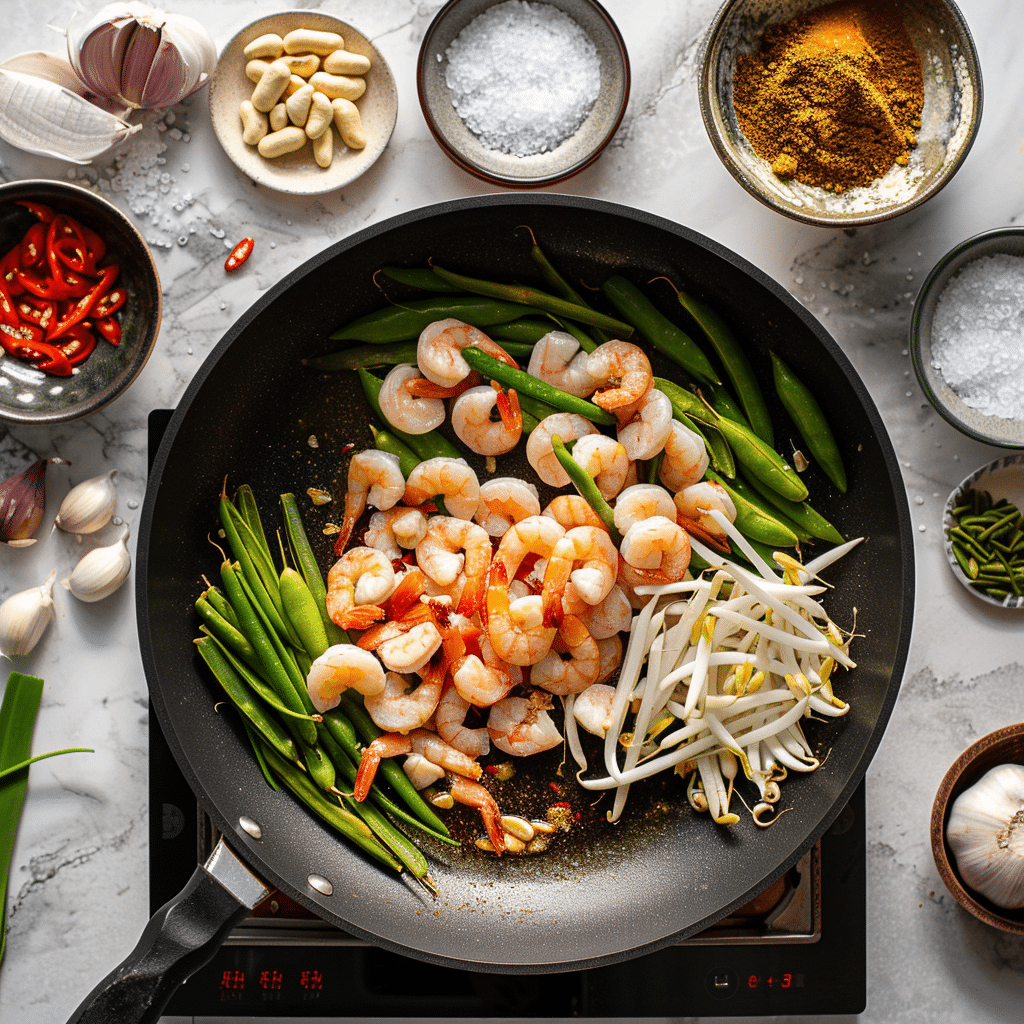
Cooking Thai Stink Beans with Shrimp is as much about technique as it is about ingredients. Here’s how to do it right.
Step 1: Prepare your curry paste
If you’re making curry paste from scratch, now’s the time to do it. Southern Thai curry paste includes ingredients like dried chilies, turmeric, lemongrass, and garlic. This is where much of the heat and flavor comes from. If you already have paste ready, skip straight to the next step.
Step 2: Peel and prep the shrimp
Remove the heads and shells of the shrimp, devein them, and wash gently. For a traditional Thai look, leave the tails on—they give a nice finish to the dish.
Step 3: Shell the stink beans
This step requires a bit of patience. Stink beans grow inside tough pods. Use a sharp knife to slice almost through the bean, then peel off the skin. You’ll notice a beige inner skin too; make sure to remove that so the beans cook evenly and taste fresh.
Step 4: Heat the wok and fry the curry paste
Place your wok on medium heat and pour in two tablespoons of oil. When the oil shimmers, add the curry paste and the shrimp paste. Stir continuously for 30–60 seconds until the paste is fragrant. The smell will be strong, spicy, and irresistible.
Step 5: Add the shrimp
Toss the shrimp into the wok and stir-fry for about 30 seconds. You’ll see the color change from translucent to bright orange-pink. If the curry paste begins to stick, splash in a bit of water.
Step 6: Add the stink beans
Now toss in the shelled stink beans. Stir-fry them with the shrimp and curry paste for another 30–45 seconds. The beans should still retain a bit of crunch when cooked properly.
Step 7: Season and finish
Add oyster sauce, sugar (if using), and torn kaffir lime leaves. Stir quickly to coat everything evenly. Taste, adjust seasonings if needed, and serve immediately with steamed jasmine rice.
This recipe might seem fast-paced, but that’s the essence of Thai cooking: quick, intense, and packed with flavor.
If you want to see variations or visual guides to peeling stink beans, I recommend visiting Eating Thai Food’s guide or Cooking With Nart’s tutorial for more visual inspiration.
Tips and Tricks for Cooking Thai Stink Beans with Shrimp
When it comes to cooking Thai Stink Beans with Shrimp, a few thoughtful tricks can make the difference between a good dish and one that feels like it came straight out of a southern Thai kitchen. Since this recipe is so bold in flavor, every little step matters, from how you prepare the curry paste to how long you stir-fry the beans.
1. Control the heat
Thai dishes are cooked quickly over high heat, but that doesn’t mean your stove should be at its absolute maximum. Too much heat will burn the curry paste before it has a chance to bloom in the oil. A medium-high flame is ideal—it lets the paste release its aromas slowly while still cooking fast enough to keep the shrimp tender.
2. Don’t overcook the shrimp
Shrimp are delicate. Once they turn opaque and orange, they’re done. Overcooking will make them rubbery and chewy, which takes away from the smooth contrast against the crunchy stink beans. Stir-fry them just until they’re barely cooked through, because they’ll continue cooking for a few seconds after you turn off the heat.
3. Handle the stink beans carefully
The biggest mistake beginners make is leaving the inner beige skin on the beans. This skin adds a bitter edge and a slightly tough texture. Always remove it before cooking. Once stir-fried, the beans should still retain a bit of snap—soft but not mushy.
4. Adjust the spice level
Southern Thai curry paste is famously spicy. If you’re not used to eating fiery dishes, start with less curry paste and build your way up. On the other hand, if you love heat, don’t be shy—add that extra spoonful of curry paste and let the chilies work their magic.
5. Taste as you go
Traditional Thai cooking doesn’t rely on strict measurements—it’s about balancing flavors. Taste after adding the seasonings. If it feels too salty, add a splash of water or a touch of sugar. If it feels too sweet, add more curry paste or a squeeze of lime.
6. Serve immediately
Thai Stink Beans with Shrimp tastes best straight from the wok. The shrimp are plump, the beans are crunchy, and the curry paste clings beautifully. If left sitting too long, the beans lose their snap, and the shrimp can dry out.
These little tricks make sure your Thai Stink Beans with Shrimp tastes just like the dish you’d enjoy in southern Thailand.
Variations of Thai Stink Beans with Shrimp
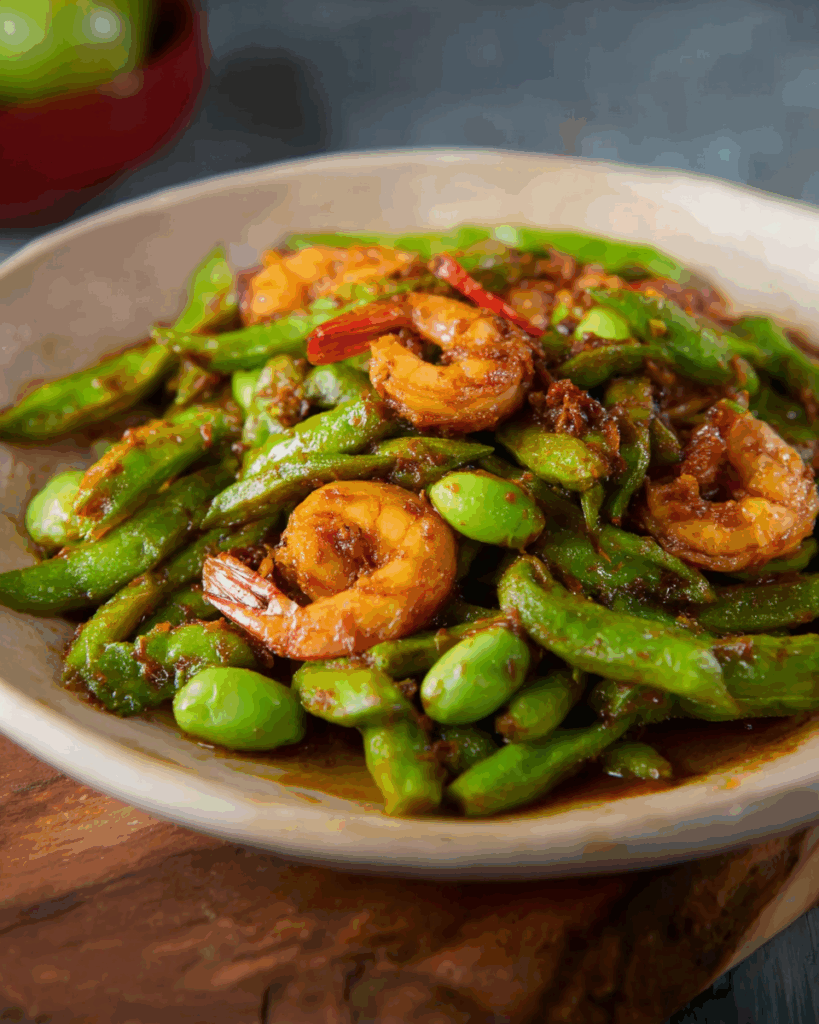
One of the wonderful things about Thai Stink Beans with Shrimp is its versatility. While the classic version is already a masterpiece, you can adapt it to your taste or dietary needs without losing the soul of the dish. Here are some creative variations:
1. Thai Stink Beans with Chicken
Not a fan of shrimp? No problem. Swap the shrimp for bite-sized chicken thigh pieces. Chicken has a rich flavor that pairs perfectly with the curry paste and beans. The cooking process remains the same, but you’ll need to stir-fry the chicken slightly longer to ensure it’s fully cooked.
2. Vegetarian Thai Stink Beans
Yes, you can make a vegetarian-friendly version! Replace shrimp with tofu cubes or even mushrooms. To mimic the depth of flavor normally brought by shrimp paste, you can use miso paste or fermented soy paste. The result is still bold and satisfying.
3. Thai Stink Beans with Pork
This is another common variation in Thailand. Pork adds a fattier, more indulgent taste compared to shrimp. Thinly sliced pork belly works especially well because the fat renders out, adding extra richness to the curry paste.
4. Curry Broth Version
If you’d like something more saucy, you can add a half cup of coconut milk after stir-frying the curry paste. This transforms the dish into a semi-curry with a fragrant broth, delicious over steamed jasmine rice.
5. Mild Version for Beginners
For those not used to spicy foods, reduce the curry paste by half and add a splash of coconut milk to mellow out the heat. This makes Thai Stink Beans with Shrimp more approachable without losing its authentic character.
6. Thai Stink Beans with Extra Vegetables
Add long beans, baby corn, or Thai eggplant for a more colorful and nutrient-packed dish. The crunchiness of vegetables balances well with the unique texture of stink beans.
These variations show how adaptable Thai Stink Beans with Shrimp can be. Whether you’re a vegetarian, a spice lover, or just someone who likes to experiment, there’s a version of this dish that will fit your table.
Nutrition and Health Benefits of Thai Stink Beans with Shrimp
When you think of Thai Stink Beans with Shrimp, the first thing that comes to mind is flavor. But this dish also packs surprising nutritional benefits that make it not only tasty but good for you.
1. Protein-Packed Shrimp
Shrimp are a lean source of protein, low in calories yet rich in nutrients like selenium, vitamin B12, and iodine. Protein helps with muscle repair and keeps you feeling full longer, making this dish satisfying without being heavy.
2. Stink Beans: The Superfood You Didn’t Know You Needed
Also known as petai beans in English, stink beans are full of fiber, which supports healthy digestion. They also contain antioxidants that protect your body from free radicals. In Thai communities, stink beans are sometimes believed to help regulate blood sugar levels.
3. Curry Paste Benefits
Southern Thai curry paste isn’t just about spice. The turmeric inside has anti-inflammatory properties, garlic boosts immunity, and lemongrass aids digestion. These natural ingredients combine to create a dish that’s as healing as it is flavorful.
4. Kaffir Lime Leaves
Often overlooked, kaffir lime leaves bring more than just aroma. They’re rich in essential oils that may have antimicrobial benefits. Plus, their refreshing citrusy notes help balance the heaviness of curry.
5. Low in Carbs
When eaten with a moderate portion of rice, Thai Stink Beans with Shrimp can fit into a balanced, low-carb lifestyle. Skip the sugar in the recipe if you’re monitoring carb intake closely.
Estimated Nutritional Breakdown (per serving):
- Calories: ~320
- Protein: 28g
- Carbohydrates: 10g
- Fat: 18g
- Fiber: 5g
Eating Thai Stink Beans with Shrimp is not only about indulging in bold flavors but also about nourishing your body with wholesome, natural ingredients.
Make-Ahead, Storage, and Freezing
Life gets busy, but that doesn’t mean you can’t enjoy Thai Stink Beans with Shrimp whenever the craving hits. With a few tips, you can prepare, store, and even freeze this dish without sacrificing flavor.
1. Make-Ahead Prep
- Peel and devein the shrimp a day before cooking. Store them in an airtight container in the fridge.
- Shell the stink beans ahead of time. They’ll stay fresh in the fridge for up to two days if stored in a sealed bag.
- Curry paste can be made in large batches and frozen in small portions. This saves a lot of time.
2. Storage
- Leftovers of Thai Stink Beans with Shrimp can be refrigerated for up to 3 days. Store them in a glass container with a tight lid.
- To reheat, use a skillet over medium heat with a splash of water. Avoid microwaving, as it can dry out the shrimp.
3. Freezing
- Shrimp don’t always freeze well after being cooked, as they can become rubbery. If you want to freeze this dish, prepare everything except the shrimp. When reheating, simply add fresh shrimp to the thawed curry and beans.
- Frozen curry paste and shelled beans can last up to 3 months in the freezer.
These tricks ensure that you’ll always be just minutes away from enjoying Thai Stink Beans with Shrimp, even on your busiest days.
Common Mistakes to Avoid
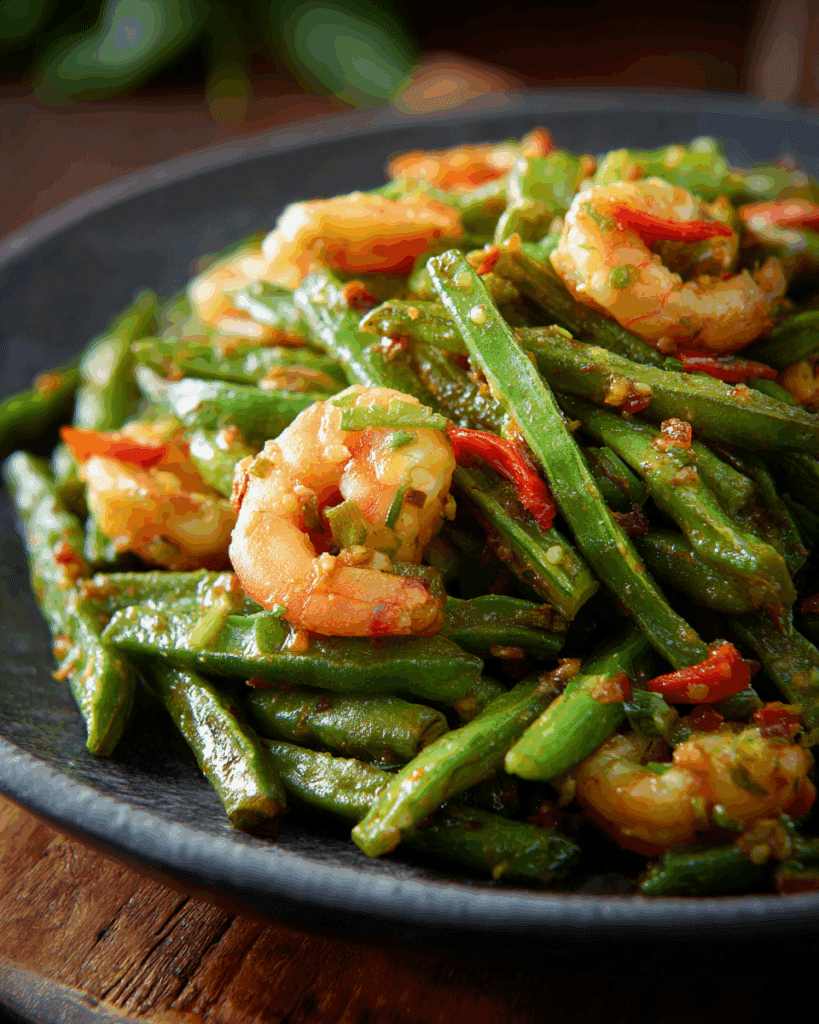
Even experienced cooks can make errors when preparing Thai Stink Beans with Shrimp. Here are the most common ones and how to fix them:
1. Overcooking the beans
Stink beans should retain crunch. Cooking them too long will make them mushy and bitter. Solution: Stir-fry them quickly—no more than a minute.
2. Burning the curry paste
If your wok is too hot, the paste can burn in seconds, leaving a bitter aftertaste. Solution: Keep the heat at medium-high and stir constantly.
3. Using too much sugar
Some recipes call for sugar, but too much can overwhelm the dish. Thai food is about balance, not sweetness. Solution: Add sugar sparingly, and taste as you go.
4. Skipping shrimp paste
Some cooks leave out shrimp paste because of its strong smell. But it’s essential for authentic flavor. Without it, your dish will lack depth. Solution: Use just half a teaspoon—you’ll notice the difference.
5. Serving it cold
This dish loses its magic when it sits out. Solution: Always serve Thai Stink Beans with Shrimp hot, right from the wok, with freshly steamed rice.
Avoiding these mistakes ensures your version of Thai Stink Beans with Shrimp will be just as delicious as the one enjoyed in Thai kitchens.
Cultural and Historical Background of Thai Stink Beans with Shrimp
Thai Stink Beans with Shrimp is more than just a flavorful recipe—it is a reflection of southern Thailand’s culinary traditions and local identity. To truly appreciate this dish, it’s important to understand where it comes from and why it remains so beloved today.
Stink beans, known locally as sataw and sometimes called petai beans in English, grow in long twisted pods and thrive in the tropical climate of Southeast Asia. Farmers in southern Thailand harvest these pods seasonally, and the beans quickly find their way into markets and kitchens. Historically, Thai Stink Beans with Shrimp was a dish of the people—simple, spicy, and deeply tied to the land.
The pairing of shrimp with stink beans comes from practicality. Southern Thailand is bordered by the Andaman Sea and the Gulf of Thailand, making fresh seafood abundant. Combining shrimp with the earthy, slightly pungent stink beans and powerful curry paste created a meal that was inexpensive yet packed with nutrition. Families cooked Thai Stink Beans with Shrimp as an everyday dish, but it also held pride of place when guests came over.
Culturally, the dish embodies the Thai philosophy of balancing flavors—spicy, salty, bitter, and slightly sweet. The shrimp paste brings depth, the curry paste brings fire, the beans add bitterness and crunch, while a touch of sugar mellows everything out. This balance makes Thai Stink Beans with Shrimp stand out among countless Thai recipes.
The name “stink bean” often surprises people, but in Thai communities, there is nothing negative about it. The beans have a strong aroma that lingers, but locals view this as a sign of their freshness and potency. In fact, eating stink beans is considered a badge of pride in southern Thailand. Families often joke that you can smell who had Thai Stink Beans with Shrimp for dinner the night before.
Over time, Thai Stink Beans with Shrimp has traveled beyond Thailand’s borders. It’s popular in Malaysia and Indonesia as well, where the dish takes on slight variations but keeps the core combination of shrimp, beans, and spices. Even in the Philippines, people are curious about stink beans in Tagalog, often comparing them to local legumes.
What makes Thai Stink Beans with Shrimp fascinating is how it connects tradition with modernity. Younger Thai chefs now showcase the dish in upscale restaurants, plating it elegantly while still preserving its rustic soul. Meanwhile, home cooks worldwide are discovering it through recipes online, intrigued by its unique flavor profile.
So when you cook Thai Stink Beans with Shrimp, you’re not just making dinner—you’re carrying forward a cultural story that’s hundreds of years old. Every bite is a link between the coastal villages of southern Thailand and your own kitchen table.
Serving Suggestions for Thai Stink Beans with Shrimp
The flavors of Thai Stink Beans with Shrimp are bold, spicy, and complex. To enjoy them fully, you’ll want to serve the dish in ways that highlight its character while keeping the balance of your meal intact. Here are some detailed serving ideas:
1. With Jasmine Rice
The classic way to enjoy Thai Stink Beans with Shrimp is with a mound of steamed jasmine rice. The rice soaks up the fiery curry paste and balances the heat with its natural fragrance. A perfect bite is a spoonful of rice with a shrimp and a bean together.
2. With Sticky Rice
In some parts of Thailand, sticky rice is the go-to pairing. It provides a chewy contrast to the crunchy beans and tender shrimp. Eating Thai Stink Beans with Shrimp this way feels rustic and comforting, especially when shared with family.
3. With Fried Egg on Top
Add a crispy fried egg on top of your rice and Thai Stink Beans with Shrimp. The runny yolk melts into the curry paste, creating a rich sauce that takes the dish to the next level. This is a common street-food style twist you’ll find in southern Thai towns.
4. As Part of a Thai Feast
In Thailand, no meal is ever just one dish. Serve Thai Stink Beans with Shrimp alongside a clear soup like tom yum goong and a mild stir-fry like pad pak boong (morning glory). This way, the boldness of the stink beans is balanced with lighter flavors.
5. With Fresh Vegetables on the Side
Thais often serve spicy dishes with raw cucumber slices, Thai eggplant, or long beans on the side. These vegetables act as natural coolers against the heat of Thai Stink Beans with Shrimp.
6. Drinks to Pair With
To cool your palate, pair Thai Stink Beans with Shrimp with iced Thai tea, coconut water, or even a light lager beer. The sweetness of the drinks helps balance the intensity of the curry paste.
7. Leftovers as a Rice Topping
If you have leftovers of Thai Stink Beans with Shrimp, reheat them and serve over day-old fried rice. The curry paste clings beautifully to the rice, creating an entirely new but equally delicious meal.
Serving Thai Stink Beans with Shrimp is about balance, variety, and comfort. Whether you keep it simple with jasmine rice or go all out with a full Thai spread, this dish always takes center stage.
When people discover Thai Stink Beans with Shrimp, they often search for related dishes, terms, and questions. Let’s explore some of these naturally:
- Thai stink beans with shrimp recipe: Many cooks look for step-by-step guides just like the one above. This recipe remains the most authentic and reliable way to prepare it at home.
- Authentic Thai stink beans with shrimp: Authenticity matters. True Thai cooking means balancing the heat of curry paste with the bitterness of stink beans and the sweetness of shrimp.
- Stinky beans side effects: Some people worry about the strong smell of stink beans. It’s true that after eating Thai Stink Beans with Shrimp, your breath and even urine might carry the aroma for a day or two. This isn’t harmful, just natural.
- Stink bean recipe: Beyond shrimp, stink beans can be stir-fried with pork, chicken, or even tofu. Still, Thai Stink Beans with Shrimp remains the most famous and beloved variation.
- Stink beans in Tagalog: In the Philippines, many wonder if stink beans have a local equivalent. While there isn’t an exact match, they’re often compared to local legumes.
- Goong pad sataw: This is simply the Thai name for Thai Stink Beans with Shrimp, used by locals across the country.
- Petai beans in English: Another way people refer to stink beans. Knowing this term helps when searching for the beans in international stores.
- Shrimp paste: Essential to the flavor of the dish, shrimp paste is a fermented condiment that adds incredible umami depth. Without it, Thai Stink Beans with Shrimp would lose much of its authenticity.
By exploring these related queries, you gain a broader perspective on why Thai Stink Beans with Shrimp is such a sought-after recipe, both in Thailand and abroad.
Conclusion
Cooking Thai Stink Beans with Shrimp is more than making dinner—it’s embracing the bold, vibrant spirit of Thai cuisine. This dish combines shrimp, curry paste, shrimp paste, and stink beans into a perfect balance of flavors that’s as exciting as it is comforting.
From peeling the beans to stir-frying the shrimp, every step connects you to generations of Thai families who have been cooking this dish for centuries. Whether you serve it simply with jasmine rice or as part of a larger feast, Thai Stink Beans with Shrimp always delivers an unforgettable experience.
If you’ve never cooked with stink beans before, don’t let the name scare you. They’re not only edible but incredibly delicious. Once you try them in Thai Stink Beans with Shrimp, you’ll understand why this dish is treasured in southern Thailand and increasingly popular worldwide.
So next time you’re craving something bold, authentic, and a little adventurous, give Thai Stink Beans with Shrimp a try. And when you do, share it with family and friends—the same way Thai families have shared it for generations.
FAQ
How do I find stink beans for Thai Stink Beans with Shrimp?
Stink beans, or petai beans, are often sold in Asian grocery stores. If you can’t find them fresh, some stores carry them frozen. Either way, they’re essential for making authentic Thai Stink Beans with Shrimp.
Can I substitute the shrimp in Thai Stink Beans with Shrimp?
Yes, you can replace the shrimp with chicken, pork, or tofu. Each variation brings a slightly different texture and flavor, but the dish still remains delicious.
Are there any health concerns or side effects with Thai Stink Beans with Shrimp?
The main side effect of Thai Stink Beans with Shrimp is the strong smell that lingers in your breath and urine. It’s harmless and completely natural, but if you’re eating it before a big meeting, keep that in mind.
What does Thai Stink Beans with Shrimp taste like?
Thai Stink Beans with Shrimp has a unique taste that’s spicy from the curry paste, savory from the shrimp paste, slightly bitter from the beans, and balanced by the sweetness of shrimp. The flavor is bold but beautifully harmonious.
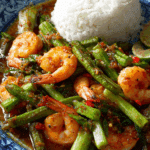
Thai Stink Beans with Shrimp
- Prep Time: 20 minutes
- Cook Time: 10 minutes
- Total Time: 30 minutes
- Yield: 4 servings 1x
- Category: Main Dish
- Method: Stir-Fry
- Cuisine: Thai
- Diet: Halal
Description
Thai Stink Beans with Shrimp is a bold and authentic southern Thai stir-fry made with fresh shrimp, stink beans (petai), and a fiery southern curry paste. This dish is packed with spicy, savory, and slightly bitter flavors, creating a truly unique balance that represents the heart of Thai cuisine.
Ingredients
- 400 grams shrimp (peeled and deveined, tails optional)
- 2–3 heaping tbsp southern Thai curry paste
- 1 cup shelled stink beans (about 6 pods)
- ½ tsp shrimp paste
- ½ tbsp oyster sauce
- ½ tbsp sugar (optional, adjust to taste)
- 6–8 kaffir lime leaves (torn)
- 2 tbsp oil for frying
Instructions
- Make a batch of southern Thai curry paste, or prepare store-bought curry paste if available.
- Peel and devein the shrimp, leaving the tails on if desired for presentation.
- Peel the stink beans by slicing the pods, removing the tough outer skin, and discarding the beige inner skin.
- Heat 2 tbsp of oil in a wok over medium heat.
- Add the curry paste and shrimp paste, stir-frying for 30–60 seconds until fragrant.
- Add the shrimp and stir-fry for 30 seconds until they begin turning pink.
- Toss in the stink beans and stir-fry for another 30–45 seconds, keeping the beans crunchy.
- Season with oyster sauce and sugar, stirring to coat evenly.
- Add torn kaffir lime leaves, mix well, and serve hot with steamed jasmine rice.
Notes
- You can substitute shrimp with chicken, pork, or tofu.
- Always remove the inner beige skin from stink beans for better texture.
- If the curry paste sticks, add a splash of water to create a light sauce.
- Use less sugar or omit it for a healthier, less sweet version.
- Serve immediately for best flavor and texture.
Nutrition
- Serving Size: 1 plate
- Calories: 320
- Sugar: 3g
- Sodium: 780mg
- Fat: 18g
- Saturated Fat: 4g
- Unsaturated Fat: 13g
- Trans Fat: 0g
- Carbohydrates: 10g
- Fiber: 5g
- Protein: 28g
- Cholesterol: 180mg
Keywords: Thai Stink Beans with Shrimp, Goong Pad Sataw, Petai beans recipe, Authentic Thai stir-fry, Shrimp paste curry, Southern Thai dish


